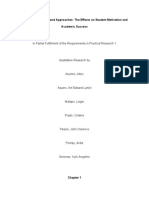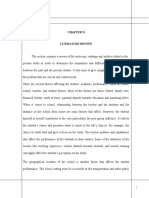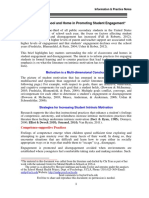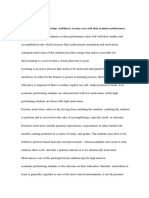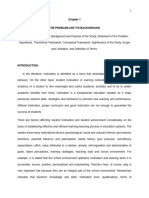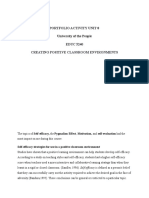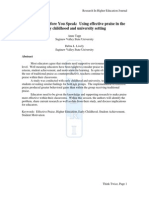5691 17779 1 PB
5691 17779 1 PB
Uploaded by
Dmdm00Copyright:
Available Formats
5691 17779 1 PB
5691 17779 1 PB
Uploaded by
Dmdm00Original Title
Copyright
Available Formats
Share this document
Did you find this document useful?
Is this content inappropriate?
Copyright:
Available Formats
5691 17779 1 PB
5691 17779 1 PB
Uploaded by
Dmdm00Copyright:
Available Formats
International Journal of Business and Management
www.ccsenet.org/ijbm
A Study of University Students Motivation and Its Relationship with Their Academic Performance
Hasan Afzal (Corresponding author) Independent Researcher, Hong Kong 1903 Un Shing House, Un Chau Estate Cheung Sha Wan, Kowloon, Hong Kong E-mail: hasanmphil@gmail.com Imran Ali Assistant Professor, Department of Management Sciences COMSATS Institute of Information Technology, Lahore, Pakistan E-mail: imranalinim@gmail.com Muhammad Aslam Khan Associate Professor, Faculty of Business Administration, Preston University, Islamabad, Pakistan E-mail: aslamnuml@yahoo.com Kashif Hamid Lecturer, Department of Business Management Sciences University of Agriculture Faisalabad, Pakistan E-mail: kashifboparoy@hotmail.com Abstract God-gifted talents, best teachers and best schooling augment the academic performance and students motivation is prerequisite for students accomplishment. This study attempts to identify the influence of students motivation on their academic performance. The sample of 342 individuals studying in different universities of Pakistan was selected. Questionnaires comprising three parts were sent directly to targeted segment. In the first part, the first few questions are related to personal information; second part consists of thirty questions of The University Student Motivation and Satisfaction Questionnaire Version 2, which was used to measure students extrinsic and intrinsic motivation, and last part is related to academics performance of the students. The study delineates that students motivations dimensions extrinsic motivation and intrinsic motivation has positive impact on academic performance of students. Academics performance amplifies between the ranges of 23 percent and 34 percent due to extrinsic motivation and intrinsic motivation and the overall model is significant (p<0.05). When we compare variables on individual bases, students who adapt self-exploratory variable and altruism variable, rejection of alternative options variable tend to perform better, whereas student who adapt career and qualifications variable, social enjoyment variable and social pressure variable tend to perform less then expected. The study accentuates that students motivation is a vital part of students success. Keywords: Students motivation, Academic performance, Intrinsic motivation, Extrinsic motivation 1. Introduction The motivation of students is an important issue in higher education, particularly owing to importance of academic performance in their professional life. This study is focused on identifying the factors that will help educational thinkers to know students attitudes towards learning, what facilitates learning and what hinders in
80
International Journal of Business and Management
Vol. 5, No. 4; April 2010
the process of learning. This will assist education community to predict student academic performance and identifying the students before their grades begin to fall (Kamauru, 2000). Lumsden (1994) has investigated that passion to learn seems to shrink as children grow. Learning sometimes becomes compulsion than pleasure, thats why large number of students leaves education before graduation. Due to unpleasant attitude of students towards education very few are actually mentally present in the classroom. Student motivation is the element that leads students attitude towards learning process. Number of studies has been conducted to probe the role of student motivation toward academic performance and different definitions of students motivation have been used by various researches. For instance Lumsden, (1994) analyzed students involvement towards education and sources of their motivation. Marshal (1987) viewed students motivation as a force beneficial to the learner. Ames (1990) stated that motivation to learning is dependant on long-term, quality attachment in learning and pledge to the process of learning. Most motivation theorist believes that motivation is involved in the performance of all learned responses and leaned behavior will not occur unless it is energized. Bomia et al. (1997) has suggested student motivation as student willingness, need, desire and obligation to participate and be booming in the learning process. Student motivation is often separated into two types: Intrinsic motivation and extrinsic motivation. Intrinsic motivation: A student is intrinsically motivated when he or she is motivated from within: Intrinsically motivated students keenly engage themselves in learning out of oddity, interest, or enjoyment, or in order to achieve their own scholarly and personal goals. Dev (1997) viewed that student who is intrinsically motivated will not need any type of reward or incentive to instigate or complete a task. This type of student is more likely to complete the chosen task and eager by the challenging nature of an activity. Lepper (1988) viewed intrinsic motivation for own sake for the enjoyment it provides, the learning it permits, or the feeling of accomplishment it evokes. Extrinsic motivation: Dev, (1997) viewed that extrinsically motivated student engages in learning purely for attaining a reward or for avoiding some punishment. Lepper (1988) states extrinsic motivation means to obtain some reward or avoid some punishment external to the activity itself such as grades, stickers or teacher approval. Thus students with intrinsic motivation are more enthusiastic, self driven, challenging and feel pleasure in their studies and students with extrinsic motivation try to drag themselves with academic assignments, feel compelled to learn, and always put minimal efforts to achieve maximum appreciations. Intrinsically motivated, students tend to utilize strategies that require more effort and that allow them to process information more intensely. Condry and Chambers (1978) found that when students were confronted with multifarious intellectual tasks, those with an intrinsic direction used more logical information-gathering and decision-making strategies than did students who were extrinsically motivated. Students with an intrinsic orientation also tend to prefer tasks that are fairly challenging, whereas extrinsically oriented students incline toward tasks that are low in degree of difficulty. Extrinsically oriented students are prone to put forth the minimal amount of effort necessary to get the maximal reward (Lepper, 1988). Brooks et al., (1998) states that to motivate students extrinsically, students should be publicly recognized for their academic achievements; which may be done through giving out stickers, candy, and other rewards; and taking away privileges, such as recess, on the basis of students' poor academic performance. In intrinsic and extrinsic motivation we have found the following sources of motivation which has also been confirmed by the students during data collection. <Insert Figure 1 here> Motivation is state of mind that stimulates activities and human body actions. The figure 1 provides a brief overview of the different sources of student motivation that are under consideration. The distinctive source intrinsic or extrinsic motivated can be traced from observation of individual in classroom or in other work environments. The sources of motivation have been explained in details in table 1 below. It is important to know what factors shape student motivation and how intrinsic motivation can be incited into the students. Many studies have been conducted to identify the factors that influence in development of student motivation. Brophy (1986) suggested motivation to learn as an ability acquired through general experience but motivated most directly through modeling, communication of expectations and direct instruction or socialization by other e.g. parents and teachers. So teachers and parents are the main intermediaries who play an important role in development of students motivation. <Insert table 1 here>
81
International Journal of Business and Management
www.ccsenet.org/ijbm
Parents being the most initial source of information introduce the world to their children and help them to understand and create the image of outside world by answering their questions, familiarizing them to different situations, telling different rituals and stories and thus children develop their attitude towards life and learning. Certainly if children have developed confidence, sense of self-worth and competence they will be ready to take challenges and successes. On the other hand if children do not perceive themselves competent they will develop an internal fear of failure or cost for appreciation or reward. So it is very important how they start their first fight. Sometimes parents are so curious about their childs education and career that they keep reminding and injecting the minds of their child that education is the only solution to future miseries. Even they threaten to punish their child for poor performance. In such circumstances the child believes that education is compulsion for them and is inevitable to survive. Large number of students could not get rid of their fears and often fail to continue. School policies and goals in academic settings are also few factors that influence in development of student motivation. Lastly unnecessary external rewards can also attract students to achieve certain level of performance as suggested by Brooks et al., (1998). In academic institutions the role of teacher is very vital to help students to develop an attitude towards learning. Raffini (1993) ascertained that beliefs of teachers about themselves, their teaching nature of the expatiations they hold for students exert powerful influence on students behavior towards learning. Deborah et al. (1999) also stated that large number of students attempt to learn if their teacher expect them to learn. So teachers should view themselves as active socialization agent capable of stimulating students motivation to learn (Brophy, 1986). Stipek (1988) and Proctor (1984) also emphasized the role of teacher efficacy as a powerful input element related to student motivation. In brief motivational factors are the predictors of academic performance. This study will investigate the influence of intrinsic and extrinsic motivational factors on academic performance. It is hypnotized that students who have high intrinsic motivation will achieve higher Grade Point Average (GPA) and their performance will remain constant. Whereas students who are extrinsically motivated will have low GPA and their performance may not remain constant. 2. Research Methodology 2.1 Sample The sample consisted of 342 university students of different programs in various universities of Islamabad and Lahore, Pakistan. The students were asked about how motivated they are about their university experience and what really motivated them to study. The questionnaire was distributed among both male and female students. There were 82% male and 18% female students in the survey with an average age of 20 years. The following technical card contains the brief information regarding research methodology: Purpose of study Exploration Types of investigation Correlations Extent of researchers interference Minimal Study setting Non-contrived Measurement Scaling Unit of analysis Individuals Sampling design Simple random sampling Sample size n = 250 Time horizon One shot Data collection method Questionnaire Data analysis Analysis of Variance The above given self explanatory table describes different parts of research methodology in brief. For statistical purpose analysis of variance has been conducted using SPSS 17 version. 2.2 Instrumentation and Measurement The University Student Motivation and Satisfaction Questionnaire version 2" (TUSMSQ2) instrument was developed by Neill (2004) to measure students motivation. TUSMSQ2 instrument contains 30-items. The questions measure both Intrinsic and Extrinsic motivation of students. There were two intrinsic motivators; Self-exploration and Altruism and four extrinsic motivators; rejection of Alternative options, career and qualifications, Social enjoyment, and Social pressure in the questionnaire. The questions were based on five point Likert scale. For each item, students rated themselves on a scale of 1 to 5; 1 being Very False, towards, 5 being Very True.
82
International Journal of Business and Management
Vol. 5, No. 4; April 2010
The following items contain the key to sources of motivation mentioned in the survey: Rejection of Alternative options (Extrinsic) 1, 7,13,19,25 Self-exploration (Intrinsic) 2, 8,14,20,26 Career and Qualifications (Extrinsic) 3, 9,15,21,27 Social enjoyment (Extrinsic) 4, 10,16,22,28 Social Pressure (Extrinsic) 5, 11, 17, 23, 29 Altruism (Intrinsic) 6, 12,18,24,30 The above mentioned self-explanatory table contains the key of the items mentioned in the survey questionnaire. This shows that each source in given due consideration in the survey and items were mixed in the survey regarding the source of student motivation. 2.3 Procedure The questionnaires were distributed randomly among the students of different programs of different semesters and their responses were collected. Data was analyzed using SPSS for Windows (version 17.0) for accurate analysis and results. Analysis included regression analysis, and analysis of variance (ANOVA). 3. Result and Discussion The following report begins with the results of the respondents information on segments like gender and languages. This study, conducted on the student motivation and its Impact on student performance, revealed that 82.4% respondents are male while 17.6% female, who participated in this study. Female segment of the sample is comparatively insignificant in the study. This study reveals percentages of languages: of these, 34.5% respondents belong to Punjabi language, 8.6% respondents belong to Sindhi language, 10.8% respondents belong to Pashto language, 6.5% respondents belong to Saraiki language, 33.5% respondents belong to Urdu language, 0.7% respondents belong to Hindco language and 5.4% respondents belong to Baluchi language. Different languages are spoken in various parts of the country. However, in one university students come from different parts of the country and speak different languages. Four major provincial languages and three other languages, commonly spoken in some of the provinces, were also included in the study. Languages reflect cultural values of their respective provinces. Now we have a clear picture of the respondents answers regarding student motivation and student performance, as shown in the table: <Insert table 2 here> Table 2 reports the results of regression analyses with the values of R-Square=0.80 and the F-statistics= 16.010. The results reveal that the model is significant (p<.10) and there is a strong relationship between independent and dependent variables. The independent variables of the study show strong relationship with the dependent variable. The variables when compared on an individual basis, all variables are insignificant (p>. 05). The regression coefficient for Rejection Alternative Option is 0.173, which suggests that employee performance is sensitive to Rejection Alternative Option and increase by 17% due to it. The regression coefficient for Career Qualification is 0.088, which suggests that employee performance is sensitive to Career Qualification and increase by 08% due to it. The regression coefficient for Social Enjoyment is 0.069, which suggests that employee performance is sensitive to Social Enjoyment and increase by 07% due to it. The regression coefficient for Social Pressure is 0.035, which suggests that employee performance is sensitive to Social Pressure and increase by 03% due to it. The regression coefficient for Self Exploration is 0.100, which suggests that employee performance is sensitive to Self Exploration and increase by 10% due to it. The regression coefficient for Altruism is 0.112, which suggests that employee performance is sensitive to Social Pressure and increase by 11% due to it. The model is overall significant (p<.10) and all independent variables are significantly important to student performance, though with varying degree of importance. The results describe the understanding of student performance through elements of extrinsic and intrinsic motivation. <Insert table 3 here> Table 3 reports the results of regression analyses with the values of R-Square=0.79 and the F-statistics=24.585. The results reveal that the model is significant (p<.05) and there is a strong relationship between independent and dependent variables. The independent variables of the study show strong relationship with the dependent variable. The variables when compared on an individual basis, both the variables are insignificant (p<. 05). The regression coefficient for extrinsic motivation is 0.342, which suggests that employee performance is sensitive to extrinsic motivation and increase by 34% due to it. The regression coefficient of intrinsic motivation is 0.237 in this model and significant, which means that it decreases employee performance by 23%. The model is overall
83
International Journal of Business and Management
www.ccsenet.org/ijbm
significant (p<.05) and both independent variables are significantly important to student performance, though with varying degree of importance. 4. Discussion Rejection of alternative options, career and qualifications and social pressure imbue the academic performance. Similarly, intrinsic motivation achieved through respect of altruism, and self-exploration. This study investigates student motivation and its impact on student academic performance. Student performance will increase between 23 percent and 34 percent due to extrinsic and intrinsic motivation. T-value of both tables show relevant importance of elements of extrinsic and intrinsic motivation for academic performance. Overall model is significant. This study reveals R-square is 80 percent which show strong relationship of students motivation with their performance. Academics performance will increase 34 percent due to extrinsic motivation where as academics performance will increase 23 percent due to intrinsic motivation. Every student has diversified experience of knowledge, abilities, talents and aspirations and come from different social, regional and political backgrounds which may affect their motivation to learn. Some student having abundance of skill due to best schooling and other are vice versa. However, student motivation is a prerequisite of academic performance (Masitsa, 2008). Effective learning in the classroom depends on the teachers ability, which creates interest related to subject matter. Student performance depends upon the forces which are affecting during the studies (Ericksen, 1978). There is no magical formula for accessing accurate level of students motivation other then extrinsic motivation and intrinsic motivation questionnaire. 5. Conclusion and Recommendations The study examined the influence of student motivation on academic performance. The study found positive and mutually causal relationship between students motivation and students academic performance. This relationship is reciprocal, meaning students who are more motivated perform better and student who perform better become more motivated. In this study, R-square is 80 percent, this shows very strong relationship of students motivation with academics performance. T-value also shows relevant importance of students motivation toward the student academics performance. Extrinsic and intrinsic motivations enhance their academic performance between ranges of 23 percent and 34 percent. When we checked on individual element of extrinsic motivation and intrinsic motivation, we found that Academics performance will increase 17 percent due to rejection alternative option. Academics performance will increase 09 percent due to career qualification. Academics performance will increase 07 percent due to social enjoyment. Academics performance will increase 04 percent due to social pressure. Academics performance will increase 10 percent due to self exploration. Academics performance will increase 12 percent due to altruism. Blank (1997); Dev (1997); Kushman (2000) and Woods (1995) also associated high motivation and engagement in learning as consisted link to reduce dropout rates and increase levels of student performance. From these findings we conclude that students who are intrinsically motivated perform much better academically than students who are extrinsically motivated. Extrinsically motivated students might do a good job or perform well to achieve a certain reward, but it does not keep them motivated for long-term and over all performance does not change or is consistent. They might perform very well in one semester or quiz to achieve a certain reward or goal and then next semester might show poor performance because the reward did not exist anymore. Their performance does not remain constant as a result. Students who are intrinsically motivated take up tasks or perform well academically for their own interest and for their own learning. These kinds of students are truly interested in learning and in achieving high goals. This shows in their overall consistent performance. From these results and Analysis, this study concludes that academic performance is positively influenced by intrinsic motivation and negatively affected by extrinsic motivation. Further research is required to address the question that How students intrinsic motivation can be increased? References Ames, C. A. (1990). Motivation: What Teachers Need to Know. Teachers College Record, Vol. 91, No. 3 pp. 409-421. Blank, W. (1997). Authentic instruction. In W.E. Blank & S. Harwell (Eds.), Promising practices for connecting high school to the real world (pp. 15-21). Tampa, FL: University of South Florida. (ERIC Document Reproduction Service No. ED 407 586)
84
International Journal of Business and Management
Vol. 5, No. 4; April 2010
Bomia, L., Beluzo, L., Demeester, D., Elander, K., Johnson, M., & Sheldon, B. (1997). The Impact of Teaching Strategies on Intrinsic Motivation. Champaign, IL: ERIC Clearinghouse on Elementary and Early Childhood Education. Bowen, W., & Bok, D. (1998). In the shape of the river: Long term consequences of considering race in college and university relations. Academic Outcomes, 53-90. Brophy, J. (1986). On Motivating Students. Occasional Paper No. 101. East Lansing, Michigan: Institute for Research on Teaching, Michigan State University, 73 pages. Condry, J., and J. Chambers. (1978). Intrinsic Motivation and the Process of Learning. In the Hidden Costs of Reward, edited by M.R. Lepper and D. Greene. 61-84. Hillsdale, New Jersey: Lawrence Erlbaum Associates, Inc. Deborah J. Stipek, Karen B. Givvin, Julie M. Salmon and Valanne L. MacGyvers. (1999). In the Eyes of the Beholder: Students and Teachers Judgments of Students Motivation. University of California, Los Angeles. Dev, P.C. (1997). Intrinsic motivation and academic achievement: What does their relationship imply for the classroom teacher? Remedial and Special Education, 18(1), 12-19. Ericksen, S. C. (1978). The Lecture." Memo to the Faculty, no. 60. Ann Arbor: Center for Research on Teaching and Learning, University of Michigan, Huitt W. (2000). Motivation to Learn: An Overview, Educational Psychology Interactive. Valdosta State University. Kamauru R. J. (2000). Intrinsic and Extrinsic Motivation Predict Academic Performance of College Students. Morehouse College. Kushman, J.W., Sieber, C., & Heariold-Kinney, P. (2000). This isn't the place for me: School dropout. In D. Capuzzi & D.R. Gross (Eds.), Youth at risk: A prevention resource for counselors, teachers, and parents (3rd ed., pp. 471-507). Alexandria, VA: American Counseling Association. Lepper, M. R. (1988). Motivational Considerations in the Study of Instruction. Cognition and Instruction, 5(4), 289-309. Lumsden, L.S. (1994). Student Motivation to Learn. Educational Resources. Information Center, Digest Number 92. Marshall, H. H. (1987). Motivational Strategies of Three Fifth-Grade Teachers. The Elementary School Journal, 88(2), 135-50. Masitsa G. (2008). Tracing the development of poor student motivation and performance in township secondary schools. Africa Education Review, Volume 5, Issue 1 June, pages 84-. Neill J. (2004). The University Student Motivation and Satisfaction Questionnaire version 2. (TUSMSQ2), Centre for Applied Psychology, University of Canberra. Osborne, J.W. (1998). Identification with academics predicts academic success among community college students. Unpublished manuscript. Proctor, C. (1984, March). Teacher expectations: A model for school improvement. The Elementary School Journal, 469-481. Raffini, J. (1993). Winners without Losers: Structures and Strategies for Increasing Student Motivation to Learn. Boston: Allyn and Bacon, 286 pages. Richmond. (1994). Motivation in Education Research, Origins and Applications of Motivation Theory by Jonathon M. Maslow. Stipek, D. (1988). Motivation to learn: From theory to practice. Englewood Cliffs, NJ: Prentice Hall. Tuckman & Sexton. (1990). Using Frequent Testing to Increase Students' Motivation to Achieve, Bruce W. Tuckman. The Ohio State University. Woods, E.G. (1995). Reducing the dropout rate. In School Improvement Research Series (SIRS): Research you can use (Close-up No. 17). Portland, OR: Northwest Regional Educational Laboratory. Retrieved October 2, 2000. [Online] Available: http://www.nwrel.org/scpd/sirs/9/c017.html
85
International Journal of Business and Management Appendix A Closed Items and Codes
www.ccsenet.org/ijbm
The 30 items in The University Student Motivation and Satisfaction Questionnaire Version 2 (TUSMSQ version 2) are displayed in the table, along with the item numbers, variable codes (for use in data analysis), the target factor, and the response scale. No. 1 2 3 4 5 6 7 8 9 10 11 12 13 14 15 16 17 18 19 20 21 22 23 24 25 26 27 28 29 30 Factor RA SE QC SO SP AL RA SE QC SO SP AL RA SE QC SO SP AL RA SE QC SO SP AL RA SE QC SO SP AL I attend university because I dont know what else to do. to understand myself better. to gain valuable skills for my career. because its fun place to be. because others expect me to get a degree. because I genuinely want to help others. because its a better alternative than working. because I want to explore new ideas. to enhance my job prospects. because I enjoy the social life. because other people have told me I should. because I want to contribute to society. to avoid being unemployed. because I want to challenge myself. in order to get the qualification. because I enjoy the social environment. because it would disappoint other people if I didn't. because I want to help solve society's problems. because it gives me something to do. for my personal growth and development. because it will help set up my future career. because of the social opportunities. it seems to be the recommended thing to do. because I want to improve the world situation. because I dont have any better options. because I love learning. so I can get a better job. because its a great place to develop friendships. of social expectations from those around me. because I want to be more useful to society.
86
International Journal of Business and Management Table 1. Sources of Motivation Sources of Motivation Intrinsic Self-exploration Altruism Extrinsic Rejection of Alternative Options Career and Qualifications Social Enjoyment Social Pressure
Vol. 5, No. 4; April 2010
Student with full motivation and is actually interested in learning and exploring ideas for its own sake. Believed to do well and show good result. e.g. I attend university because I have a genuine interest in the subject I am studying. Wants to learn for own satisfaction, becoming useful to the society, helping others and solving their problems. Believe to be genuinely motivated and show better results. e.g. I attend university because I want to be more useful to society. Concerned with their careers and more inclined towards completing the degree only to get good jobs in future. Continuing studies just to avoid working or because does not know what else to do. Believed to be de-motivated and can not keep a consistent performance academically. e.g. I attend university because I dont know what else I would do. Concerned with their careers and inclined towards completing the degree only to get good jobs in future. Concerned with getting the degree but not for learning sake. Believe to show good performance but not for long-term or where the reward does not exist anymore. e.g. I attend university to enhance my job prospects. View University as a socializing place where they can have fun and make friends. De-motivated students who are thought to show very little academic performance. e.g. I attend university because I enjoy the social life. Surrounded by social pressures, peers, parents, etc. Try to live up to others expectations. Do not have genuine interest in studies with no consistency. e.g. I attend university because others expect me to get a degree.
87
International Journal of Business and Management
www.ccsenet.org/ijbm
Table 2. Regression analysis of elements Student Motivation and University Student Performance Variables Constant Rejection of Alternative Option Career Qualification Social Enjoyment Social Pressure Self-Exploration Altruism R-Square F-Statistic Significant Dependent Variable: Student Performance Table 3. Regression Analysis of Students Intrinsic and Extrinsic Motivation & Student Academic Performance Variables Constant Extrinsic Motivation Intrinsic Motivation R-Square F-Statistic Significant Coefficient Beta 1.005 .342 .237 0.79 24.585 .000 Std. Error .358 .168 .118 t-Value 2.808 2.039 2.007 Sig. .015 .062 .066 Coefficient Beta 1.075 .173 .088 .069 .035 .100 .112 .80 16.010 .009 Std. Error .520 .163 .233 .346 .271 .229 .150 t-Value 2.067 1.065 .378 .198 .130 .437 .744 Sig. .069 .315 .714 .847 .899 .672 .476
Dependent Variable: University Student Performance Student Motivation
Extrinsic Motivation Rejection of Alternative Options Career & Qualifications
Intrinsic Motivation Self-exploration Altruism
Social Enjoyment Social Pressure Figure 1. Sources of Student Motivation
88
You might also like
- Student Motivation and Learning: AbstractDocument6 pagesStudent Motivation and Learning: AbstractGynesis Lim RoqueroNo ratings yet
- Five Key Ingredients For Improving Student MotivationDocument23 pagesFive Key Ingredients For Improving Student MotivationPolly Anna100% (1)
- Research Proposal-Intrinsic MotivationDocument6 pagesResearch Proposal-Intrinsic MotivationMustafa TekkeNo ratings yet
- Group 5 CHAPTER 1 3 REVISEDDocument17 pagesGroup 5 CHAPTER 1 3 REVISEDcristine joy pradoNo ratings yet
- Background 1Document14 pagesBackground 1Anonymous Ua1VXZksikNo ratings yet
- A Study About Factors Affecting Interest and Motivation of A StudentDocument6 pagesA Study About Factors Affecting Interest and Motivation of A StudentElla UyNo ratings yet
- Motivation Research FullDocument17 pagesMotivation Research FullafiqahNo ratings yet
- Student Motivation: An Annotated Bibliography by Angela Shaw June, 2014 ED7999 Master's ProjectDocument19 pagesStudent Motivation: An Annotated Bibliography by Angela Shaw June, 2014 ED7999 Master's ProjectSòniaSuñerNo ratings yet
- RRLDocument35 pagesRRLSi Pi TiNo ratings yet
- MotivationDocument13 pagesMotivationFRANCIESNo ratings yet
- Classroom and Environmental Factors Shaping MotivationDocument31 pagesClassroom and Environmental Factors Shaping MotivationMae SaranteNo ratings yet
- Positive Reward: Strategic Approach in Motivating Grade 6 Pupils of Obrero Central Elementary SchoolDocument14 pagesPositive Reward: Strategic Approach in Motivating Grade 6 Pupils of Obrero Central Elementary SchoolKatherine DahangNo ratings yet
- How Does Motivation Impacts The Behavior of Grade-8 Students of Palmes School of Antipolo?Document16 pagesHow Does Motivation Impacts The Behavior of Grade-8 Students of Palmes School of Antipolo?Jhoreanna AgoncilloNo ratings yet
- role-of-teachers-motivation-in-teachingDocument5 pagesrole-of-teachers-motivation-in-teachingStepheson AraújoNo ratings yet
- Dennis Et Al 2007 The Little Engine That Could - How To Start The Motor - Motivating The Online StudentDocument13 pagesDennis Et Al 2007 The Little Engine That Could - How To Start The Motor - Motivating The Online StudenthoorieNo ratings yet
- The Role of School and Home in Promoting Student EngagementDocument8 pagesThe Role of School and Home in Promoting Student EngagementMary Ann A. MonaresNo ratings yet
- Keywords: STEM Students, Top Academic Achievers, Motivation, Habits, Dealing With AcademicDocument31 pagesKeywords: STEM Students, Top Academic Achievers, Motivation, Habits, Dealing With AcademicMarie ThereseNo ratings yet
- Aksum UniversityDocument27 pagesAksum UniversityAbraham BarrekaNo ratings yet
- The Use of Motivation in Academic ExcellenceDocument23 pagesThe Use of Motivation in Academic ExcellencebenjaminowakaNo ratings yet
- Why Do I Study and What Do I Want To Achieve by Studying Understanding The Reasons and The Aims of Student EngagementDocument18 pagesWhy Do I Study and What Do I Want To Achieve by Studying Understanding The Reasons and The Aims of Student EngagementAlex RichieNo ratings yet
- Chapter 1.group 10Document6 pagesChapter 1.group 10iamloui123No ratings yet
- Annotation - GineteDocument4 pagesAnnotation - GineteRaymark Gil Dela CruzNo ratings yet
- Impact of Motivation On Academic Achievement: Doi: 10.17051/ilkonline.2020.04.764716Document5 pagesImpact of Motivation On Academic Achievement: Doi: 10.17051/ilkonline.2020.04.764716calma3961No ratings yet
- Session 12 Expectations For Success: Motivation and LearningDocument16 pagesSession 12 Expectations For Success: Motivation and Learningwazim saffieNo ratings yet
- Didactica Especifica I ResumenDocument38 pagesDidactica Especifica I ResumenAnonymous vWGIbfPNo ratings yet
- Students Develop Confidence in Many Ways With Their Academic PerformanceDocument11 pagesStudents Develop Confidence in Many Ways With Their Academic PerformanceTewfik TGrNo ratings yet
- Effect of Study Habits On Academic Performance of Grade 12 Abm Students in Consolacion National High School Day Class Rationale of The StudyDocument12 pagesEffect of Study Habits On Academic Performance of Grade 12 Abm Students in Consolacion National High School Day Class Rationale of The StudySheena Jean AlinNo ratings yet
- Motivation in Learning and TeacingDocument15 pagesMotivation in Learning and TeacingsariNo ratings yet
- How Motivation Influences Student Engage PDFDocument39 pagesHow Motivation Influences Student Engage PDFCristie SumbillaNo ratings yet
- Mini Research Group GenanibanDocument11 pagesMini Research Group GenanibanGenaniban Glenville BelarminoNo ratings yet
- CompleteDocument55 pagesCompleteOlalekan MichaelNo ratings yet
- The Effects of Motivation On Students' Academic PerformanceDocument13 pagesThe Effects of Motivation On Students' Academic PerformancelinhNo ratings yet
- English 10Document19 pagesEnglish 10Julyah PicardalNo ratings yet
- NEW Micah Research Chapter 1 5Document52 pagesNEW Micah Research Chapter 1 5paulinemicahdelacruz15No ratings yet
- Related Literature and StudiesDocument4 pagesRelated Literature and Studiesremilynhipolito100% (3)
- Self-Study Project Intrinsic and Extrinsic MotivationDocument7 pagesSelf-Study Project Intrinsic and Extrinsic Motivationapi-247222888No ratings yet
- 5240 Portfolio Activity Unit 8Document9 pages5240 Portfolio Activity Unit 8KUNWAR JEE SINHANo ratings yet
- Psychology Final-AssignmentDocument8 pagesPsychology Final-AssignmentNhi TranNo ratings yet
- The Effect of Student Learning Motivation On Learning SatisfactionDocument26 pagesThe Effect of Student Learning Motivation On Learning SatisfactionNastya ZhukovaNo ratings yet
- Teacher Motivation DissertationDocument5 pagesTeacher Motivation DissertationCanSomeoneWriteMyPaperForMeMadison100% (1)
- KAP Assignment 1Document5 pagesKAP Assignment 1WanSyamNo ratings yet
- Effectiveness of Reward As A Modifier On Students Behavior at Primary LevelDocument10 pagesEffectiveness of Reward As A Modifier On Students Behavior at Primary LevelAiza SapulNo ratings yet
- Unit 3 Student MotivationDocument19 pagesUnit 3 Student MotivationrabiaNo ratings yet
- Think Twice Before You Speak: Using Effective Praise in The Early Childhood and University SettingDocument9 pagesThink Twice Before You Speak: Using Effective Praise in The Early Childhood and University SettingPascual Emilio MolinaNo ratings yet
- Motivational Factors To Promote Students' Interest and Involvement in Teaching-Learning English PDFDocument14 pagesMotivational Factors To Promote Students' Interest and Involvement in Teaching-Learning English PDFGlobal Research and Development ServicesNo ratings yet
- TeachingexceptionalmakingadifferenceDocument6 pagesTeachingexceptionalmakingadifferenceapi-301935239No ratings yet
- Motivating Students: My Students Aren't Motivated - How Can I Help Them?Document5 pagesMotivating Students: My Students Aren't Motivated - How Can I Help Them?Sharmistha Talukder KhastagirNo ratings yet
- Research Paper 1Document8 pagesResearch Paper 1api-656454154No ratings yet
- Current Motivational Edited NewDocument34 pagesCurrent Motivational Edited NewLachica DennisNo ratings yet
- What Motivation Is and Why It Is Important in Classroom SituationDocument14 pagesWhat Motivation Is and Why It Is Important in Classroom SituationWiljohn de la CruzNo ratings yet
- Effective TeachingDocument14 pagesEffective TeachingMagnus Acquah-DoughanNo ratings yet
- Reflection Learning TheoryDocument9 pagesReflection Learning TheoryIntan SayangNo ratings yet
- AB McFatridge LDocument6 pagesAB McFatridge LLee McFatridgeNo ratings yet
- Final StudyDocument21 pagesFinal StudyHannah SmithNo ratings yet
- The TheoreticalDocument3 pagesThe TheoreticalMariel Cordero100% (1)
- RRLDocument6 pagesRRLMarie Faith DumpaNo ratings yet
- Students On The Academic MotivatorsDocument24 pagesStudents On The Academic MotivatorsCrisheila Sarah PiedadNo ratings yet
- About Student Attitudes On LearningDocument8 pagesAbout Student Attitudes On LearningSabeeqa MalikNo ratings yet
- Effective Homework Strategies: Instruction, Just Do It, #2From EverandEffective Homework Strategies: Instruction, Just Do It, #2No ratings yet
- Classroom-Ready Resources for Student-Centered Learning: Basic Teaching Strategies for Fostering Student Ownership, Agency, and Engagement in K–6 ClassroomsFrom EverandClassroom-Ready Resources for Student-Centered Learning: Basic Teaching Strategies for Fostering Student Ownership, Agency, and Engagement in K–6 ClassroomsNo ratings yet
- 2.9 Algebra RelayDocument2 pages2.9 Algebra RelayJon PeadNo ratings yet
- TP1 - Introduction To Accounting & AuditDocument21 pagesTP1 - Introduction To Accounting & AuditAntonius MulyonoNo ratings yet
- L4 Paper #1-2 Setting The Ancient Records StraightDocument38 pagesL4 Paper #1-2 Setting The Ancient Records Straightnikos nevrosNo ratings yet
- Girl in Translation: by Jean KwokDocument3 pagesGirl in Translation: by Jean KwokHoàng Ân LiễuNo ratings yet
- Malay To EnglishDocument311 pagesMalay To EnglishRIZKY RIFKYNo ratings yet
- Prosocial Behaviour: Hans W. BierhoffDocument20 pagesProsocial Behaviour: Hans W. BierhoffSahil Mushaf100% (1)
- Lesson PlanDocument6 pagesLesson PlankaidefuentesNo ratings yet
- Foreign PolicyDocument9 pagesForeign PolicyPrashant vasuniya100% (1)
- Impacts of Parental Involvement Chap 1 3 Final EditDocument14 pagesImpacts of Parental Involvement Chap 1 3 Final EditRachelle Calandria100% (1)
- Macbeth Reading ControlDocument2 pagesMacbeth Reading ControlScribdTranslationsNo ratings yet
- What Is Cost-Min PDFDocument8 pagesWhat Is Cost-Min PDFcristi6923No ratings yet
- Anomalis A: Film Analysis by CG BamboDocument12 pagesAnomalis A: Film Analysis by CG BamboCG Patron BamboNo ratings yet
- Effects of The Community Support Program (CSP) Conducted by The Philippine National Police and Armed Forces of The Philippines in SagadaDocument9 pagesEffects of The Community Support Program (CSP) Conducted by The Philippine National Police and Armed Forces of The Philippines in SagadaJaymae Ngipol GaonaNo ratings yet
- Assignment 1 Front Sheet Qualification BTEC Level 5 HND Diploma in Computing Unit Number and Title Unit 3: Professional Practice Submission DateDocument21 pagesAssignment 1 Front Sheet Qualification BTEC Level 5 HND Diploma in Computing Unit Number and Title Unit 3: Professional Practice Submission DateChopper Tony TonyNo ratings yet
- COMEDY of MannersDocument2 pagesCOMEDY of MannersAlexis GogoașăNo ratings yet
- Sex Spectra - Jennifer HamlinDocument16 pagesSex Spectra - Jennifer Hamlinapi-459206314No ratings yet
- Christine Eibs, Former CEO, Inspires Young Women To Work HardDocument7 pagesChristine Eibs, Former CEO, Inspires Young Women To Work HardemilysingerNo ratings yet
- Class 9Document2 pagesClass 9Vikash SinghNo ratings yet
- Retinitis PigmentosaDocument12 pagesRetinitis PigmentosaHa Sakinah SeNo ratings yet
- Wa0000.Document174 pagesWa0000.YUVA ProductionNo ratings yet
- Paradoxical Darkening and Removal of Pink Tattoo Ink JOCD Jun 2010Document3 pagesParadoxical Darkening and Removal of Pink Tattoo Ink JOCD Jun 2010disco8No ratings yet
- Role of Children in The Family Buying ProcessDocument27 pagesRole of Children in The Family Buying ProcessriganNo ratings yet
- Examples of Open Loop and Closed Loop Control System PDFDocument2 pagesExamples of Open Loop and Closed Loop Control System PDFLoriann100% (2)
- What Is StatisticsDocument25 pagesWhat Is StatisticsDeepakgupta0001No ratings yet
- Fresh Properties of The Self-Compacting High-Performance Concrete Using Recycled Concrete AggregateDocument7 pagesFresh Properties of The Self-Compacting High-Performance Concrete Using Recycled Concrete AggregateDinesh KumarNo ratings yet
- Transfer Order LatesDocument265 pagesTransfer Order LatesAaimen abbasNo ratings yet
- GG 17Document2 pagesGG 17sindhu50% (2)
- Class #2 February 18Document8 pagesClass #2 February 18Leoandi lopezNo ratings yet
- Answers To M1 A Level Questions Edexcel Past PapersDocument3 pagesAnswers To M1 A Level Questions Edexcel Past PapersnpmmorrisNo ratings yet
- New Discoveries at The Dinosaur Capital of The World: Read The Selection Below and Answer The Questions That Follow ItDocument2 pagesNew Discoveries at The Dinosaur Capital of The World: Read The Selection Below and Answer The Questions That Follow ItGS - 12ZZ 721316 Bramalea SSNo ratings yet



